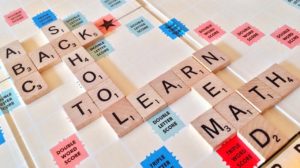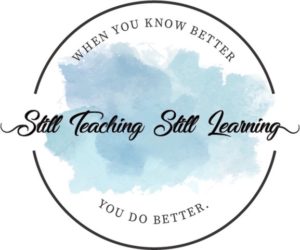How is your school year going so far? Do you have good routines and procedures in place? Have you established your classroom behavior expectations and are most students following them? If you feel like you could use a little reset in your classroom, read on for how to re-establish your classroom behavior expectations!
*First, think about your procedures for how students enter your classroom. Do you expect them to follow a certain routine or to begin working on certain assignments? Think about what you want them to do and how you are communicating that expectation.
For example, I greet my students at the door every morning and when we change classes. I post directions on the board for my class to follow. For my fifth-grade homeroom classroom, I vary the directions from day to day, but Monday’s routine is always the same, Tuesday’s routine is always the same, etc. For my fifth-grade math class (my partner teacher’s class), I also post directions, but we begin with a “do now” warm-up task every day.

No matter what you are doing, think about what you want your students to do and how you want them to do it. Think about what you might need to do to ensure that they know the expectation. Do you need to post directions? Do you need to model and practice the entire routine? Even if your routine and procedures have not changed since the beginning of the year, but your students (or you) are getting slack about following that routine, discuss it as a class. Then practice it (this can be fun, believe it or not), and be intentional about enforcing the expectation every single day.
*Next, think about your routines and procedures during class. Do you need to post an agenda so that students know what is coming next and what they need to do when they finish work? How should your students move from one activity to the next? How do you distribute papers? How do you communicate the appropriate voice level for each activity? What do you do if students are not being productive?
For example, I teach fifth grade and we start every class with a meeting/mini-lesson. During the meeting, I go over the class agenda for that period or subject. When everyone knows what is going to happen, I find that students relax and are ready for the lesson part.



When it is time for the lesson, I tell them exactly what materials they need to have at their seats or workspaces (pencil, clipboard, Chromebook, highlighter, some previously used work that is in their binder, etc.).
During the lesson, I am monitoring closely to see that students are engaged and on task. If it’s only one or two students, I redirect them and change where they are sitting if necessary. If several students are off task, I reset the whole class by saying something like, “We are not focused on the work we need to do right now. Everyone put your pencils down (Chromebook lids down, whatever), and stretch. Take a deep breath in and let it out. Think to yourself, ‘Right now I need to be ________..” Okay, we’re ready to get back on track.”



When it is “work time” (after the lesson), I post the list of directions which might look like this:
1 – finish reading/annotating your article;
2 – add notes to your graphic organizer;
3 – put both papers in your reading folder in your binder;
4 – switch to independent reading;
5 – groups 1 and 2 will meet with me today.
With this procedure, students know where to look and see what to do next. They can be independent because they know what to do. If they are going to meet with me in a small group, they are alerted to that fact and don’t need to keep checking to see if we’re going to meet. (Sometimes I even post the time when I will meet with each group).
This posted list of directions eliminates misunderstanding about what to do next. By the way — this is easier to do if you use something like Classroom Screen or if you have typed these directions in advance on a Google slide or on paper to display under the document camera. Often the same directions can be reused from one day to the next.



*Now, think about procedures for how you end your class. Many teachers find it very effective to have some sort of closure at the end of class. To do this, you need to end your students’ work time about five minutes earlier to ensure time for this. How do you want students to clean up their workspace? How do you want them to line up? Make a list of the tasks you want your students to complete. Consider posting them on a chart — someplace where you and the students can see the list daily. Then go through each task with your class, practicing it until they have it down.



*When you are re-introducing your procedures, re-introduce your rules and explain the consequences. It’s also fine to tell your students that you are doing this because you have not been doing your main job which is to protect their right to learn.
*As far as consequences go, you may need to abide by your school discipline plan. If there is no set plan, you might try the following classroom management plan from Michael Linsin’s awesome website Smart Classroom Management. First, give a warning. Michael recommends . . .
. . . a warning only works when its purpose is to allow students to fix their mistakes on their own.
A warning is another way of saying:
You broke a class rule, but I trust that you will check yourself and ensure that it doesn’t happen again.
If the student breaks a rule again, they move to time-out (they need to be separated from “the fun”, which I define as being with the rest of the class and doing what they are doing).
The third consequence is a letter home to parents. In my class, we use a reflection sheet. Students write about what they were doing that was a problem for the class, then they write about what they are going to do to change the behavior. I also include a line about “how the teacher could help me”, where they can list what they might need from me (or from another teacher, if it happened in their class) to change the behavior.



Sometimes I get good tips from students about how other people might be triggering something, or how something else happened that I didn’t even know about. I include that category because it shows that I care about the student and about their behavior, and I want to help them correct it. In other words: I am on their side.
The last step in this process is to send the reflection sheet home. Some teachers like to just send it home with the student and require it to be signed and returned the next day. I prefer to take a picture of the reflection and email that to the parent, along with any other explanation I feel necessary. This way, I keep the reflection sheet, I don’t have to worry about collecting paper or reminding students to return it, and it gives the parents the immediate information. No parent likes to receive this news, but they do appreciate being kept informed.



*Another great tip from Michael Linsin’s site: how to give directions and stop repeating yourself. You can read about it HERE.
In short, his tips include: stop moving & stand in one place, ask for students’ attention, give your direction in as few words as possible, pause, ask if anyone does not know what to do, give your go signal. Then the next two steps are also crucial: don’t help and don’t repeat the directions. Students will quickly learn to either ask other students or to look around and figure out what to do themselves. Either way, they will be listening closely to you the next time.
*Speaking of giving directions, I like to use Aaron Burr’s advice to Alexander Hamilton in the musical Hamilton: “talk less, smile more.” Slow down and talk less. Wait until your students are ready and waiting for your directions instead of trying to talk over them. Instead of talking about how they should behave, enforce your consequences without lecturing or getting emotional.



*If your whole class needs a “reset”, follow Michael’s tips HERE. The steps are: stop them in their tracks (ask for their attention and wait until you have every single student), ask for one minute of silence during which you all take slow, deep breaths, tell them, “In a moment, you are going to . . .”, give your directions (see above tip for how to give directions), ask if anyone does not know what to do, observe them follow the directions, then move on. No lectures or anything further. Just a simple reset.
*Consider re-arranging your classroom. Something about a new arrangement (including different seats for everyone) gets students’ attention.



*As you implement (or re-implement) these routines in your classroom, consider using music as a prompt for each routine. You might even make a class playlist on Spotify so that it’s easy to cue up each song when it’s time to make a transition. One fun idea I’ve seen is to use this site of television theme songs. Choose some songs that you like and teach them as the prompt for your students to complete the routine.
And finally — remember self-care.
Remember to take deep breaths at least once an hour. Put a reminder on your laptop or on your phone — whatever gets your attention and reminds you to do it!
Stay hydrated. Use a large water bottle and drink half your body weight in ounces of water every single day.



Try very hard to get enough sleep at night. Every classroom discipline mistake I have ever made was directly connected to sleep deprivation.
Eat food that is healthy for you (especially 8- 10 fruit and veggie services every day) and cut down on processed food.



Do some form of exercise daily. If you don’t have time for a full-fledged workout, do some calisthenics, yoga poses, or just walk. But do something that moves and stretches your body daily.
Remember that every day is a good day for a reset. You don’t have to wait until the beginning of the next quarter or the beginning of the month or week. Just pick a day that works for you and start. You and your students will benefit, no matter when you reset!
I would love to hear from you if you try these tips or if you have more suggestions!
Do you want more guidance with resetting your classroom? I’m creating a mini-course with more step-by-step tips. Sign up for the waiting list HERE and I will notify you when it’s ready! (Signing up does not obligate you in any way.)
